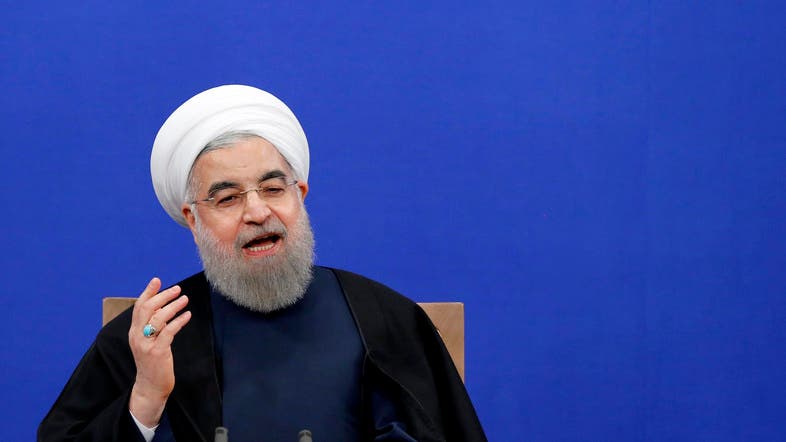
Iranian President Hassan Rowhani addresses a press conference in Tehran on January 17, 2017, to mark the first anniversary of the implementation of the nuclear deal. (AFP)
by Tony Duheaume
It was during the 30th summit of the Gulf Cooperation Council (GCC), which took place in Kuwait in December 2009, Iran’s attempts at destabilizing Yemen came into the spotlight, when delegates expressed their solidarity with Saudi Arabia over its struggle to repel Shiite Houthi rebels based in north Yemen from their territory.
These rebels were positioned along the edge of Saudi Arabia’s sensitive southern border, they entered Saudi territory in cross-border incursions, and breaching the sovereignty of the kingdom, they struck at targets in blatant acts of aggression.
Where the Iranians are members of the Twelver sect of Islam, the Houthis in the Sa’ada province of northern Yemen are Zaidi Shiites who revere the first four imams of Islam. But with the Iranian offer of weapons to the Four Shiite sect, plus logistical aid, the Iranian regime soon found their new proxy force easy to manipulate. In no time at all, they had the Houthis doing their bidding, in a continued campaign of harassment against both Yemeni And Saudi people.
In November 2009, things really began to hot up between the Houthis and the Saudi government, after the rebels clashed with Saudi border guards in the Jabal Dukhan territory along the kingdom’s border with northern Yemen. In response to the rebel attack, Saudi helicopters carried out a series of forays in areas occupied by the Houthis, killing at least forty insurgents.
With Saudi Arabia always having been viewed by the Iranian clerical regime as a rival in their bid for supremacy of the Middle East, constant threats have been made against the country by its founder, Ayatollah Khomeini, from the moment he had come to power, spouting anti-Saudi rhetoric from almost the instant he took over.
Speeches have been delivered in Iran encouraging the Shiites of Saudi to revolt against their government. Such was Khomeini’s animosity toward Saudi Arabia that he continued with his vitriolic verbal attacks right to the very end, when he denounced them as heathens in his final will and testament.
As far as the Iranians are concerned, with Yemen’s northern border adjacent to Saudi Arabia’s southern border, the Houthis make the perfect proxy force with which to hit out at the kingdom, using this border area as a springboard for armed incursions, in a bid to cause as much instability as possible.
These rebels were positioned along the edge of Saudi Arabia’s sensitive southern border, they entered Saudi territory in cross-border incursions, and breaching the sovereignty of the kingdom, they struck at targets in blatant acts of aggression.
Where the Iranians are members of the Twelver sect of Islam, the Houthis in the Sa’ada province of northern Yemen are Zaidi Shiites who revere the first four imams of Islam. But with the Iranian offer of weapons to the Four Shiite sect, plus logistical aid, the Iranian regime soon found their new proxy force easy to manipulate. In no time at all, they had the Houthis doing their bidding, in a continued campaign of harassment against both Yemeni And Saudi people.
In November 2009, things really began to hot up between the Houthis and the Saudi government, after the rebels clashed with Saudi border guards in the Jabal Dukhan territory along the kingdom’s border with northern Yemen. In response to the rebel attack, Saudi helicopters carried out a series of forays in areas occupied by the Houthis, killing at least forty insurgents.
With Saudi Arabia always having been viewed by the Iranian clerical regime as a rival in their bid for supremacy of the Middle East, constant threats have been made against the country by its founder, Ayatollah Khomeini, from the moment he had come to power, spouting anti-Saudi rhetoric from almost the instant he took over.
Speeches have been delivered in Iran encouraging the Shiites of Saudi to revolt against their government. Such was Khomeini’s animosity toward Saudi Arabia that he continued with his vitriolic verbal attacks right to the very end, when he denounced them as heathens in his final will and testament.
As far as the Iranians are concerned, with Yemen’s northern border adjacent to Saudi Arabia’s southern border, the Houthis make the perfect proxy force with which to hit out at the kingdom, using this border area as a springboard for armed incursions, in a bid to cause as much instability as possible.






1 Comments
DC2DE0273A
ReplyDeleteTakipçi Satın Al
M3u Listesi
Erasmus
Tinder Promosyon Kodu
Avast Etkinleştirme Kodu